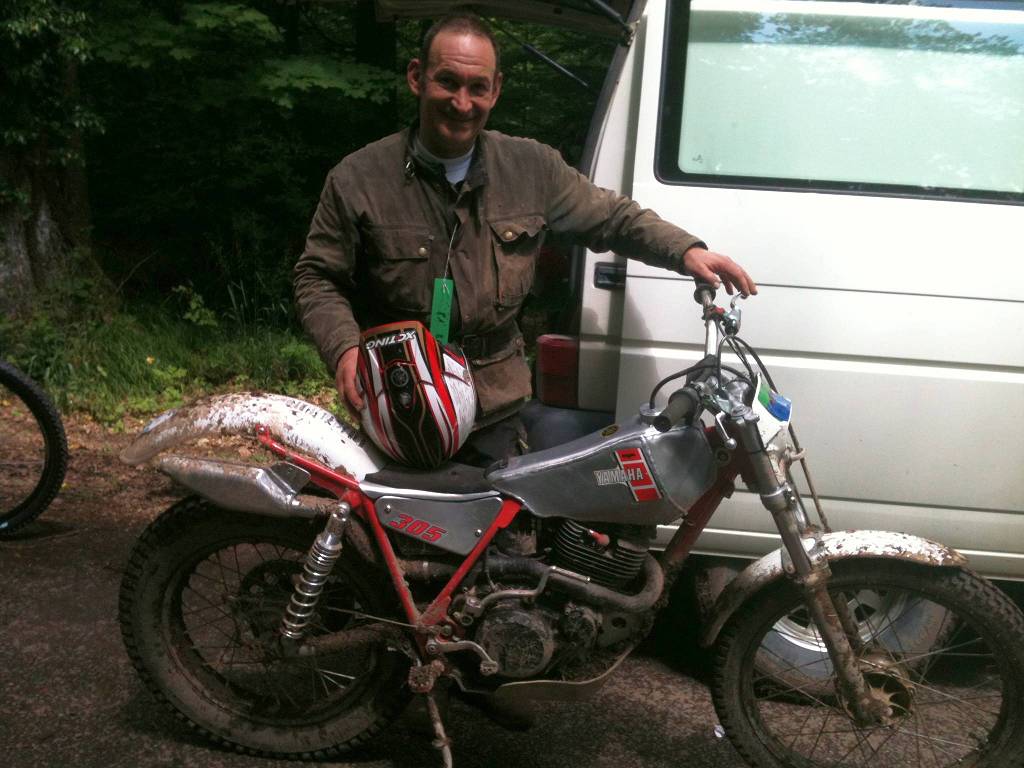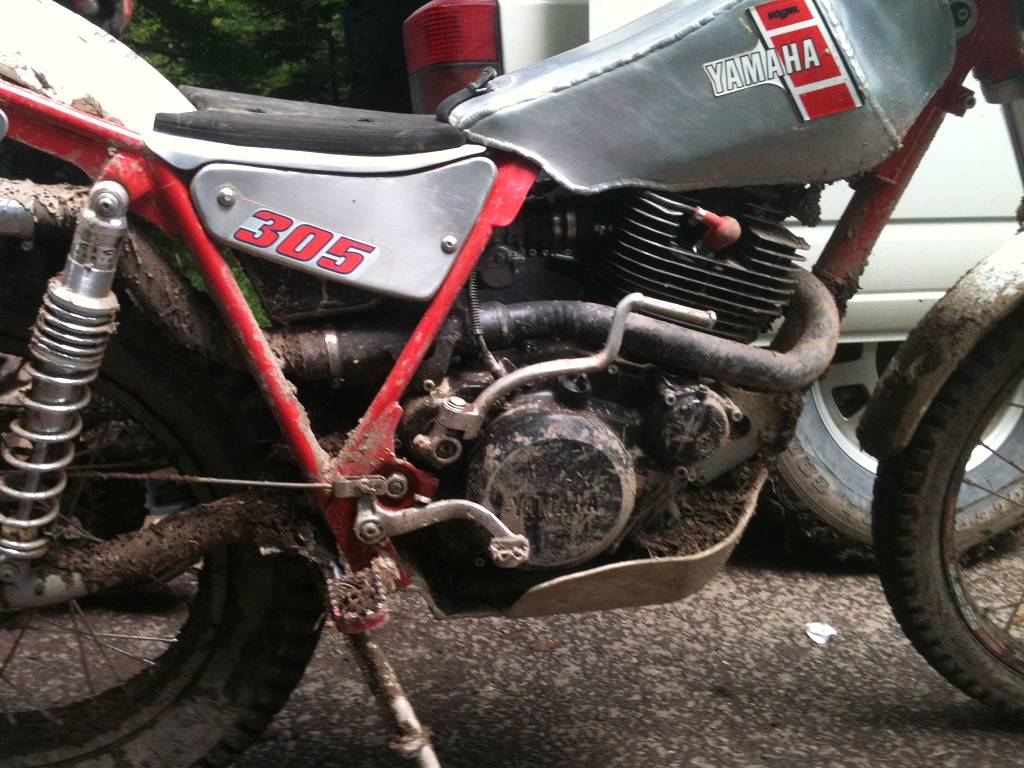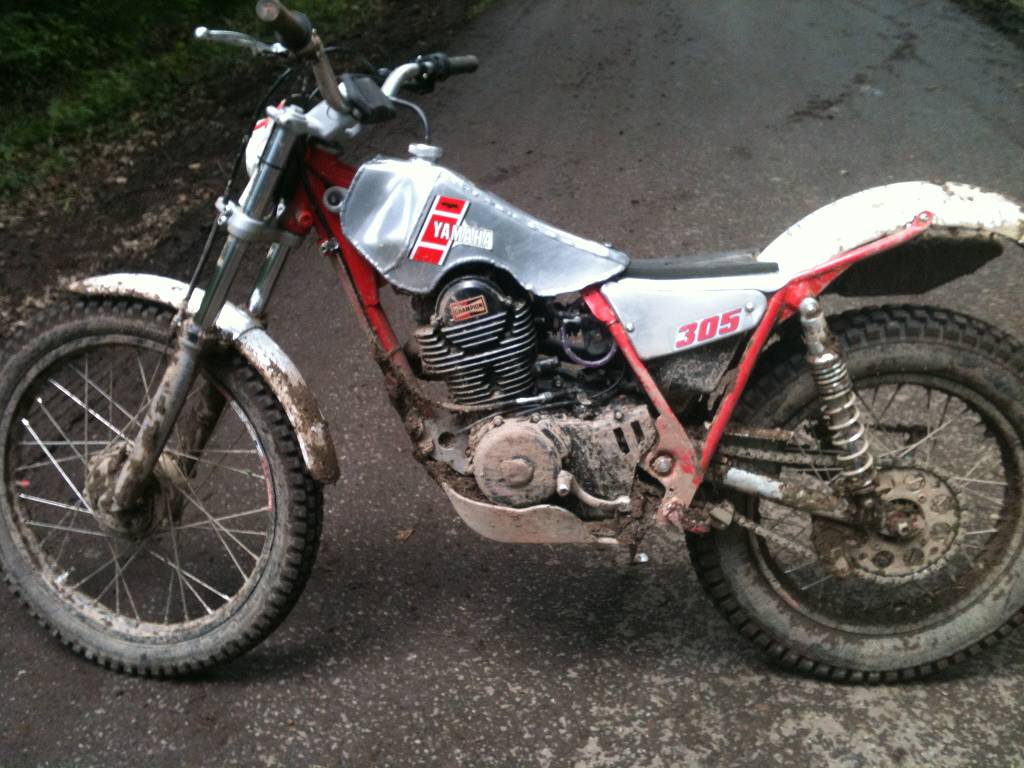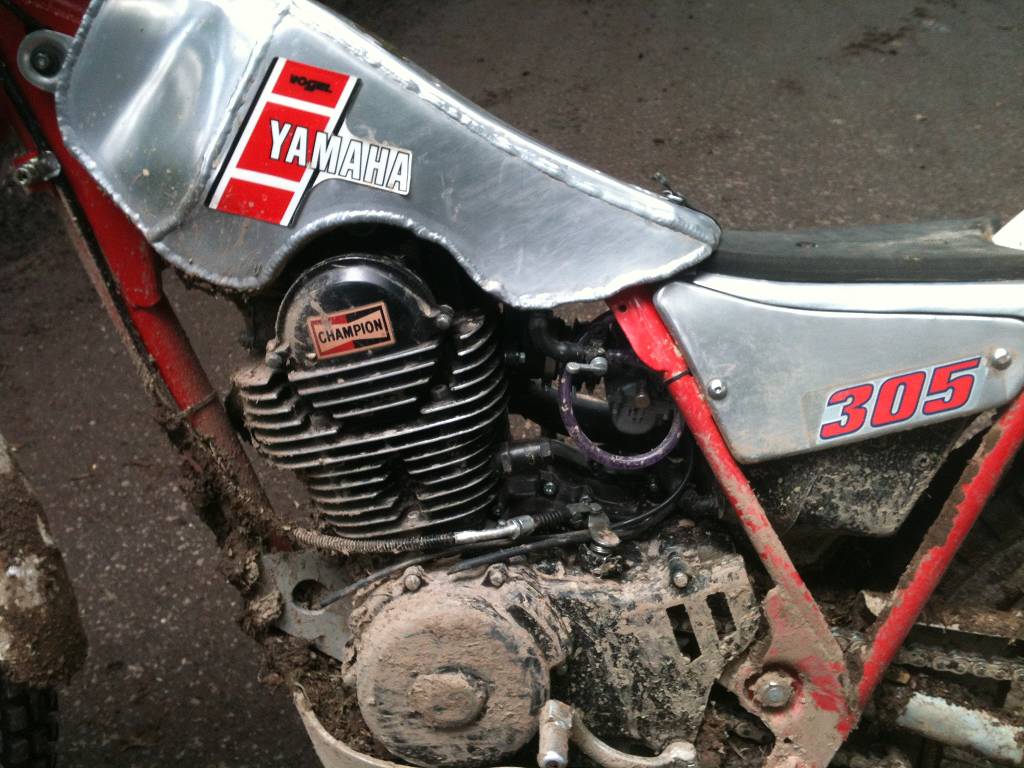



Yamaha 4 Stroke TY 305F
At the Eurocup Twinshock event on 2 June 2013 in Soultz, I met a special 4 stroker never seen before. The bike startet in the 80ies on a base of a Yamaha XT 250 Enduro by Dieter Vogel, a Yamaha dealer and Trial fan from Germany. 20 years later, his son Joachim took over the business and finished the project.
I could see Joachim Vogel in action and was very impressed.
 |
 |
| Joachim with the mud from the Soultz forrest, Alsace France | engine is nicely fitted and also the exhaust |
 |
 |
| frame is an Italjet 2T modified | nice tank, alu welded |
I had a chat with Joachim and he told me the frame was an Italet. The engine is a Yamaha XT 250 with a bore (or stroke?) of the 350.
Here also a video clip of the XTY 305 in action from zone 10 in Soultz.
So, my "abandon" on Sunday because of my broken brake pedal gave me the chance to take the video.
I hope we can see Joachim at other events in action.
Patrick
June 2013
20. August 2013
Joachim sent me the story about this Yamaha:
Hi Patrick
I wanted as soon as possible to pass the information on our Classic trial project with the XT 250 engine. The project, we call it TY305F, started in the early 80s. The show Eddy Lejeune commanded with the Honda, inspired my father to make something similar to that. As a Yamaha dealer of course it was clear to use an appropriate motor from Iwata, a crashed XT250 offered the opportunity a motor with the desired key data to be obtained. The chassis should have naturally Trial suitability, and so the business relationship with Werner Linz (Italjet importer for Germany), was very useful. A disassembled Italjet JT350 that Werner Linz used as spare parts, provided the framework and the swingarm. Thus, the base was created once, and the project could begin.
First, the engine was revised to Trial suitability. Since this came from an Enduro, of course, the essential part of the transmission first of all had to be adjusted. A short primary drive and adjusting the gear wheels for the first and third gear to second gear brought the desired success, now could be driven with a normal dimension in rear sprocket, despite a short translation. Of course, the capacity should meet the requirements in the trial sports, and thus it was clear that you extract the maximum possible from the motor base. A newly-built liner for the cylinder in combination with a plunger from the Yamaha XV750 crankcase brought the displacement to 305ccm. The bore / stroke ratio, the ideal combination of rotatory power and torque at the motor base was now there. After the engine of course also the frame had to be adjusted for the engine and reinforced. The frame geometry is, contrary to the trend in the current Classic Trial, left completely original.
In the
meantime, however, so much time had passed and Yamaha had launched the first
TY250R. Compared with these motorcycles, the TY305F would not have been more
competitive, and thus the project was put on hold.
Thirty years later, the project was resumed, as there again was a possible use
for this charming moped with the Classic series.
From a very battered TY250R the front fork and the wheels were sourced, with brakes, revised and adapted. Thus it was guaranteed that there is a proper braking action, and the weight reduction compared to the planned Italjet wheels was also an important aspect.
Now that the suspension components were gathered together, and the engine sitting in the frame, you could do the other work, such as tank, seat and side panels. The first tank experiment, a Bultaco aluminum tank, however, was placed on the shelf after finishing, it would not have fit to the line of the motorcycle. Now a separate tank was made using a wooden mold and a sand-filled leather bag. In the same way, the side cover and the seat are driven and formed from aluminum. After making the parts everything was painted accordingly or partially coated and completed. The set-up work for carburetor jetting and air filter also took time. You could already see and listen at the Euro Cup in Soultz, but in the meantime the engine runs worlds better and makes it so fun to ride, that to my other bikes no longer are used.
On your question about the weight I've finally taken a balance on hand and measured, what has brought all the weight saving. To my surprise, there was much less than I would have expected. Even with a full tank I have 42kg on the front wheel and 50kg at the rear wheel, so in total 92 kg with a full tank.
Best Regards Joachim
Hallo Patrick,
ich wollte Dir so schnell wie möglich die Informationen zu unserem Classic-Trial-Projekt mit dem XT 250 Motor zukommen lassen.
Das Projekt , wir nennen es TY305F, begann Anfang der 80er Jahre. Die Show die Eddy Lejeune mit der Honda geboten hatte, inspirierte meinen Vater etwas ähnliches auf die Räder zu stellen. Als Yamaha-Händler war es natürlich geboten einen entsprechenden Motor aus Iwata zu verwenden, eine verunfallte XT250 bot die Möglichkeit einen Motor, mit den gewünschten Eckdaten, zu erhalten. Das Fahrwerk sollte natürlich Trialtauglichkeit haben, und so war die Geschäftsverbindung zu Werner Linz (Italjet-Importeur für Deutschland), sehr nützlich. Eine zerlegte Italjet JT350 die Werner Linz als Ersatzteilspender verwendete, lieferte den Rahmen und die Schwinge. Somit war die Ausgangsbasis mal geschaffen, und die Umbaumaßnahmen konnten beginnen.
Als erstes wurde der Motor auf Trialtauglichkeit überarbeitet. Da dieser aus einer Enduro stammte, war natürlich das Getriebe der wesentliche Teil der zuallererst angepasst werden musste. Ein kurzer Primärtrieb sowie das Anpassen der Getrieberäder für den ersten und dritten Gang an den zweiten Gang brachten den gewünschten Erfolg, nun konnte trotz kurzer Übersetzung mit einer normalen Dimension beim hinteren Kettenrad gefahren werden. Natürlich sollte auch der Hubraum den Anforderungen im damaligen Trialsport gerecht werden, und somit war klar dass man das Maximalmögliche aus der Motorbasis herausholt. Eine neu angefertigte Laufbüchse für den Zylinder, in Verbindung mit einem Kolben aus der Yamaha XV750 und das Aufspindeln des Kurbelgehäuses brachten den Hubraum auf 305ccm. Im Bohrung/Hub-Verhältnis die ideale Kombination von Drehvermögen und Drehmoment bei dieser Motorbasis.
Nach dem Motor musste natürlich auch der Rahmen für die Aufnahme des Triebwerkes angepasst werden, Verstärkungen eingesetzt werden und entsprechend angebracht werden. Die Rahmengeometrie wurde jedoch, entgegen dem Trend im aktuellen Classic-Trial, vollständig original belassen.
Zwischenzeitlich war jedoch so viel Zeit verstrichen, Yamaha hat inzwischen die ersten TY250R auf den Markt gebracht, dass ein Weiterbauen keinen Sinn mehr gemacht hat. Gegenüber diesen Motorrädern wäre die TY305F nicht mehr Konkurrenzfähig gewesen, und somit wurde das Projekt auf Eis gelegt.
Dreißig Jahre später wurde das Projekt wieder aufgenommen, da es nun wieder mit den Classic-Serien eine Einsatzmöglichkeit für dieses reizvolle Moped gab.
Aus einer stark geschundenen TY250R wurden die Vordergabel und die Räder mit Bremsen entliehen, überarbeitet und angepasst. Somit war schon mal gewährleistet dass einen ordentliche Bremswirkung besteht, und die Gewichtsreduktion gegenüber den geplanten Italjet-Rädern war ebenfalls ein wichtiger Aspekt.
Nachdem nun die Fahrwerksbauteile beieinander waren, und der Motor im Rahmen saß, konnte man sich an die weiteren Arbeiten wie Tank, Sitzbank und Seitenteile machen. Der erste Tankversuch, ein Bultaco Aluminiumtank, wurde jedoch nach Fertigstellung wieder ins Regal gelegt, er hätte von der Linie nicht zum Motorrad gepasst. Nun wurde mithilfe einer Holzform und einem sandgefüllten Ledersack ein eigener Tank angefertigt. Auf dieselbe Art wurden die Seitendeckel und die Sitzbank aus Aluminium getrieben und geformt. Nach dem Herstellen der Teile wurde alles entsprechend lackiert oder teilweise auch pulverbeschichtet und komplettiert. Die Abstimmungsarbeiten für Vergaser, Bedüsung und Luftfilter nahmen natürlich auch gehörig Zeit in Anspruch. Eine Variante konntest Du ja in Soultz beim Euro-Cup sehen und hören, doch zwischenzeitlich läuft das Moped um Welten besser und macht so Spass zum Bewegen, dass meine anderen Trialmopeds nicht mehr zum Einsatz kommen. Auf deine Frage nach dem Gewicht habe ich endlich mal eine Waage zur handgenommen und mal gemessen was das ganze Gewichtssparen gebracht hat. Zu meiner Überraschung kam viel weniger zusammen als ich selbst erwartet hätte, vollgetankt habe ich 42kg am Vorderrad und 50kg am Hinterrad, also in der Summe 92kg mit vollem Tank.
Gruß Joachim